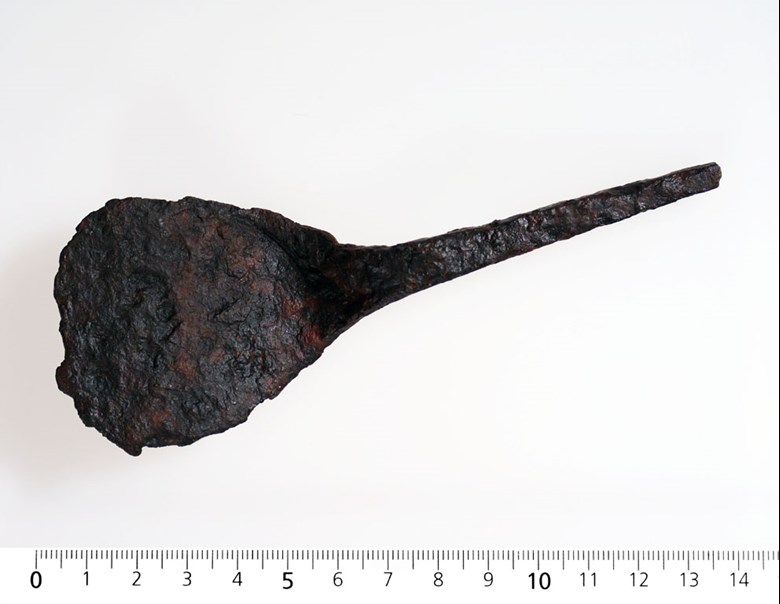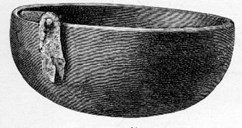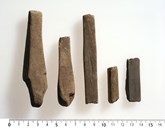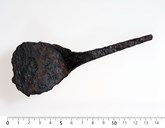Drinking glass from the continent
At this site the finds include remnants of putty used to tighten wooden vessels or tiner (round or oval wooden boxes with lid and handle), fragments of soapstone vessels, a frying pan and fire steel, a millstone and knives, in addition to whetstones. A fragment of a light green, faceted glass goblet has also been found. However, the fragment is too small to arrive at any conclusion as to its size, form or function, but it has probably been a drinking glass like the many imported glasses from the continent during this period.
Rectangular fireplaces
The dwellings at Ytre Moa had rectangular fireplaces, placed in the central axis in the inner part of the houses. The fireplaces provided both heat and light, and were, of course also used for making food. The food may have been prepared in a cooking pit, like the one found in house A. Fire steel and flint was used to light the fire.
Cooking vessels and tiner
Fragments of a soapstone vessel, probably round, have been found at Ytre Moa.These vessels were in common use in the Viking Age, which is corroborated by the many soapstone quarries from that period. We know about such quarries in Luster and Vik, but we have no knowledge whether the vessel at Ytre Moa came from any of these places.
Porridge or gruel
Porridge and gruel have probably been the staple food in the Viking Age as it was also in the old rural communities. For ordinary days porridge was made on the basis of water, whereas on special occasions it was perhaps common to make it with milk, and enjoyed with a pat of butter on top. Up until fairly recent times it was normal to make porridge and gruel in soapstone vessels. Other dishes that may have been made in soapstone vessels were sodd (a meat-broth with pearly-barley and vegetables) and soup, such as nettles soup.

Milk an important ingredient
At Ytre Moa they probably had both cows and sheep, and milking must have played an important part in the daily chores at the farm. We have only found fragments of the putty of what might have been a wooden vessel or tine. Could this have been used in connection with the milking or the processing of dairy products?
Hand millstone
Nothing has so far proved that there was a grain field at Ytre Moa. What we know for sure it that they ground the grain themselves by means of a hand millstone. Two fragments of the runner stone (the top grindstone) have been found, similar to the one uncovered in the Oseberg find. Could it be that the flour was used to bake bread in the frying pan? From Sweden we know that unleavened bread made of flour and water was baked in similar frying pans until fairly recent times. The pans have probably been used to fry meat and fish as well, even if frying on spits and grills – objects not found at Ytre Moa – admittedly was more common. Based on the bone material found at Ytre Moa, for example outside the dwelling houses, we can see that people have eaten mutton, goat meat, pork and beef. There are no finds of fish bones at Ytre Moa.
Knives and whetstones
Knives and whetstones have been important farm tools and they were used for the slaughtering of animals and cooking of meat. At Ytre Moa a total of 11 knives or knife fragments have been found. They are all of the dominant type at that time. In addition, many whetstone fragments of different types have been found – both clay slate and shale. Their forms vary as well – some are oblong with three or four sides, others are shaped like bones – and a pendant whetstone has also been found.





